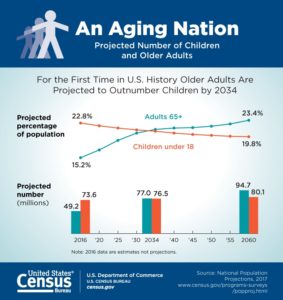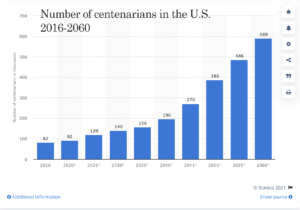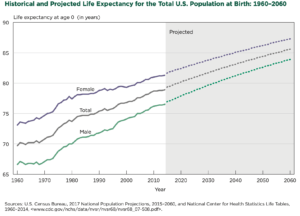There’s one important reason for the graying of America’s churches that often gets overlooked in the rush to “attract more young people.” That reason is simple and obvious to anyone who reads demographics: America as a nation is graying.
In just nine years, by the year 2030, the U.S. Census Bureau projects that one in every five living Americans will be of retirement age. That’s the year that all Baby Boomers will be 65 or older. (Right now, 10,000 Baby Boomers turn 65 every day.)
 And just four years later, by 2034, the Census Bureau projects that older adults will outnumber children for the first time in U.S. history.
And just four years later, by 2034, the Census Bureau projects that older adults will outnumber children for the first time in U.S. history.
But wait, there’s more: Also by 2030, “because of population aging, immigration is projected to overtake natural increase (the excess of births over deaths) as the primary driver of population growth for the country,” the Census Bureau adds.
After 2030, these same trends will continue to magnify. It’s not that the U.S. population won’t continue to grow — it will, through births and immigration, but also through the extended life expectancy of all Americans.
Increased life expectancy
That increased life expectancy — despite the ravages of COVID-19 — is a present reality. Think about the number of 80- and 90-year-olds who remain vibrant parts of congregational life in a way that would have been unusual 50 years ago. Think also about the number of people who celebrate 100th birthdays and are still going strong.
 The rising number of centenarians is a worldwide phenomenon, but the United States leads the world in the number of such milestone women and men, at about 97,000. That U.S. total of centenarians is projected to grow by 500,000 people by 2060 — a five-fold increase.
The rising number of centenarians is a worldwide phenomenon, but the United States leads the world in the number of such milestone women and men, at about 97,000. That U.S. total of centenarians is projected to grow by 500,000 people by 2060 — a five-fold increase.
But the major shifts in life expectancy already are visible, the bureau explains: “Between 1960 and 2015, life expectancy for the total population in the United States increased by almost 10 years from 69.7 years in 1960 to 79.4 years in 2015. Looking ahead, gains to total life expectancy are projected to increase only 6.1 years from 2016 to 2060. By 2060, total life expectancy in the United States is projected to reach an all-time high of 85.6 years. Since 1960, the largest gains in life expectancy occurred between 1970 and 1980 — an increase of about three years from 70.8 to 73.7 years.”
These major gains in life expectancy, the bureau says, are attributed to “increases in vaccinations, continued decreases in infectious diseases and cardiovascular mortality, and the effectiveness of prevention programs related to smoking, alcohol consumption and promotion of physical activity.”
 It’s not just centenarians that will be filling church pews by then but also a larger number of adults 85 to 99. The 85-plus population is expected to grow 200% by 2060.
It’s not just centenarians that will be filling church pews by then but also a larger number of adults 85 to 99. The 85-plus population is expected to grow 200% by 2060.
To better understand the coming shift in total population, consider this: By 2060, the population under age 18 is projected to show net growth of only 6.5 million people, compared to a projected net growth of 45.4 million for those 65 years and over. By 2060, the Census Bureau projects, America will be home to 95 million older adults and 80 million children. That will make the United States grayer than ever before.
But again, these trends already are visible today. In 1900, only 4% of Americans were age 65 or older. Today, more than 16% of the population is age 65 or older.
Shifting gears
Major U.S. businesses already are shifting gears for these present and future realities. Chief among those are the medical professions and the senior housing business, including independent living, assisted living and skilled nursing and memory care units.
Given that an increasing percentage of American adults already are living alone, isolation could become an even greater problem churches will be called upon to address.
Given that an increasing percentage of American adults already are living alone, isolation could become an even greater problem churches will be called upon to address. This appears to be one of the reasons traditional churches that have been generally cautious about COVID restrictions are seeing more senior adults come back to in-person activities than young families.
The demands on rural congregations may be more urgent than on urban congregations due to the risks of isolation.
Childless adults
But there’s one other demographic group that could be easily overlooked yet have a tremendous need for church engagement: Childless adults.
In 2018, Pew Research published a national survey that found among adults who at the time of the survey did not have children, 37% said they did not intend to become parents. Within many cultures, the duty for adult children to care for aging parents — regardless of where the parents live — is a backbone of the social safety net.
Older adults who are childless often find community and care from church communities. That is likely to be a growth opportunity for churches of all kinds.
LGBTQ seniors
And here’s one more variation on this data point worth considering: The growth in the number and percentage of Americans who identify as LGBTQ. While it has become more common than ever before for same-sex couples to raise children, the majority of LGBTQ Americans do not have children. And as more young adults come out earlier — thus being less likely to first be married to someone of the opposite gender and parent children — the number of childless LGBTQ senior adults will grow exponentially.
LGBTQMap reports that “although largely invisible until very recently, LGBTQ older adults make up a significant (and growing) share of both the overall LGBTQ population and the larger 65+ population. While confronted with the same challenges that face all people as they age, LGBTQ elders also face an array of unique barriers and inequalities that can stand in the way of a healthy and rewarding later life.”
“While confronted with the same challenges that face all people as they age, LGBTQ elders also face an array of unique barriers and inequalities that can stand in the way of a healthy and rewarding later life.”
The National Public Radio program “The Takeaway” recently aired a segment it titled “Aging While Queer.” The person interviewed was Michael Adams, CEO of SAGE, the country’s largest and oldest organization dedicated to improving the lives of LGBTQ older people.
“Elders in our community face a range of challenges, among them being very high levels of social isolation and thin support networks,” he said. “In fact, as we grow older, we’re four times less likely to be parents than older Americans in general and twice as likely to grow older, single and living alone, and of course, we live in a society where adult children, and partners and spouses are our primary caregivers in old age.
“The absence of them creates a lot of isolation and thin support networks, which means as we age as queer elders, we have a greater need for professional services and care. Unfortunately, when we seek to access that care, what we find is discrimination, ignorance, lack of cultural competency.”
New challenges for churches
Whether gay or straight, America’s aging population will present new challenges to churches. Today’s senior adults are more active than their parents were at the same age — if they lived that long. They’re interested in doing different things as group activities than senior adults expected from churches even 20 years ago.
In my own experience as a pastor — working alongside a gifted senior adult minister — I witnessed this generational divide firsthand. For a period of years, we had overlapping groups of the Greatest Generation and the first wave of retiring Baby Boomers, and what they expected from the church was vastly different. The oldest group wanted to gather for game days and potlucks at the church and couldn’t understand why the “younger” senior adults wouldn’t attend. The younger senior adults wanted to go places and see things.
That’s only the tip of the iceberg of what’s yet to come as the last of the Baby Boomers come of age. I know that firsthand, too, because I’m one of those myself, facing a 60th birthday this year and not feeling as old as I might look.
Related articles:
More adults than ever are unpartnered in their prime years, new research shows
Making a covenant with aging parents | Opinion by Bob Newell
U.S. churches face big ministry challenge in aging Baby Boomers


